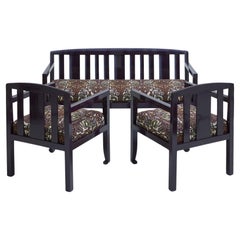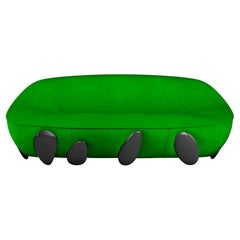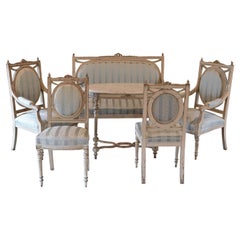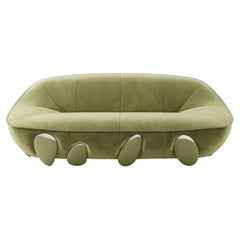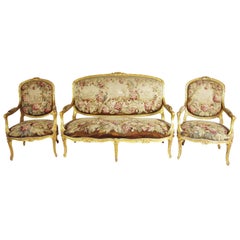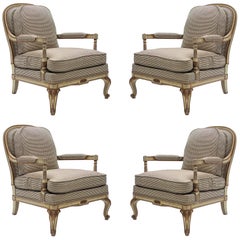Hand-Painted Living Room Sets
6
5
to
3
6
4
11
6
6
4
2
1
1
2
4
5
3
1
1
1
Height
to
Width
to
Depth
to
6
7
6
5
5
7
4
4
5
4
4
4
10
9
5
3
2
9
3
2
1
1
3
1
1
1
Technique: Hand-Painted
19th Century Italian Carved Gilt-wood Salon Suite - Sofa, Chairs & Footstools
Located in London, Park Royal
A nine piece Italian, Louis XV style, gilt-wood Suite. This masterfully handcrafted set includes one sofa, two armchairs with matching footstools, and four chairs, all unified by a a...
Category
Late 19th Century Italian Louis XV Antique Hand-Painted Living Room Sets
Materials
Beech
1930 Living Room reupholstered in Pierre Marie's fabric
By Pierre Marie
Located in PARIS, FR
1930's Chinese style French work living room, hand-brush relacquered and reupholstered in Pierre Marie's Abondance in "Maubeuge" colorway fabric.
Fabric is 80% recycled jacquard cotton, made in France...
Category
1930s French Other Vintage Hand-Painted Living Room Sets
Materials
Wood, Jacquard
Contemporary Round Bottega Green Velvet Sofa with Black Lacquered Legs
Located in Porto, PT
Contemporary Round Bottega Green Velvet Sofa with Black Lacquered Legs
Lunarys Sofa Green is a modern style sofa with a glamorous aesthetic look. Its plump volumes and welcoming desi...
Category
21st Century and Contemporary Portuguese Modern Hand-Painted Living Room Sets
Materials
Fabric, Wood, Velvet
Contemporary Round Blue Velvet Sofa with Black Lacquered Legs
Located in Porto, PT
Contemporary round blue velvet sofa with black lacquered legs
Lunarys Sofa Blue is a modern style sofa with a glamorous aesthetic look. Its plump volumes and welcoming design transform this modern sofa into the perfect cozy seating. Entirely upholstered in a bright blue fabric, don't hesitate to contact us for further details and customization options.
Materials: Upholstered in Velvet; Handpainted legs.
Dimensions: Width: 250 cm 98,4 in – Depth: 110 cm 43,3 in – Height: 90 cm 35,4 in – Seat Height: 53 cm 20,9 in
About Hommés:
HOMMÉS Studio...
Category
21st Century and Contemporary Portuguese Modern Hand-Painted Living Room Sets
Materials
Fabric, Wood, Velvet
Antique Swedish Louis XVI Style Grey-Painted Suite with Settee, Chairs & Table
Located in Miami, FL
A lovely Louis XVI style salon suite comprising of: (1) canape or settee, (2) armchairs, (2) side chairs & an oval tea table. Sweden, circa...
Category
Early 20th Century Swedish Louis XVI Hand-Painted Living Room Sets
Materials
Carrara Marble
Contemporary Round Sage Green Velvet Sofa with Handpainted Legs
Located in Porto, PT
Lunarys sofa is a contemporary style sofa that features a glamorous aesthetic look. It's an outstanding modern sofa, upholstered in bouclé an...
Category
21st Century and Contemporary Portuguese Modern Hand-Painted Living Room Sets
Materials
Wood, Fabric, Velvet
6 Piece Mid-Century Modern Rattan Patio Porch Ensemble
Located in Sheffield, MA
A hard to find complete set of rattan wicker patio, porch set (6) pieces including: 3 seater sofa, pair of arm chairs, pair of glass top side tables and coffee table with glass top. ...
Category
Early 20th Century North American Hand-Painted Living Room Sets
Materials
Wicker
Kaupüna Swing: handcrafted in the Xingu Indigenous Territory, Brazil
Located in Jundiaí, SP
Completely executed in the Kaupüna Village, located in the Xingu Indigenous Reserve, Kaupüna Swing unites the design of Maria Fernanda Paes de Barros and the indigenous handicraft tradition of the Mehinako people.
Its design rises from the desire to highlight the buriti yarn, made by women, placing it in balance with the painted solid wood traditionally made by men and already with recognized value.
It brings together the artisanal work of Mehinaku women who harvest, clean, and prepare the buriti straw to make the thread with which they weave their traditional nets, and of Mehinaku men who enter the forest to find trees from which to take the wood to create zoomorphic benches adorned with charcoal and annatto-based graphics.
The Kaupüna Swing marks the first time in Kaupüna village that men and women worked together to create a single piece, what gives it an immeasurable value and meaning.
Developed in partnership with Kulikyrda Mehinaku and Kuyawalu Aweti, it was considered by them a "new indigenous product".
It is part of Yankatu's Xingu collection...
Category
2010s Brazilian Other Hand-Painted Living Room Sets
Materials
Natural Fiber, Cotton, Wood, Straw
Pair of French Louis XVI Style Gilt, Cream /Green Painted Fauteuils Armchairs
Located in Los Angeles, CA
A fine pair of French 19th-20th century Louis XVI style two-tone cream and green painted with parcel-giltwood carved fauteuils armchairs. The intricately carved wood frames with a pa...
Category
Early 1900s French Louis XVI Antique Hand-Painted Living Room Sets
Materials
Velvet, Wood
Set of Six English Regency Side Chairs
Located in Wilson, NC
Set of six English Regency side chairs are fruitwood with floral brass medallions in the center cross splat. Each has bobbin turned crest r...
Category
Early 19th Century English Regency Antique Hand-Painted Living Room Sets
Materials
Brass
'Ameba' Limited Edition Sofa from Egli Design
Located in London, GB
Massive and yet cosy, sculptural and yet functional. It is both welcoming and comfortable.
Egli Design has struck a unique balance that makes 'Ameba' an alluring work of design. Ge...
Category
21st Century and Contemporary Lithuanian Modern Hand-Painted Living Room Sets
Materials
Silver Leaf
Related Items
Restored Bordeaux Leather Chesterfield Club Suite Armchair & Sofa on Turned Legs
Located in GB
We are delighted to offer for sale this stunning very rare handmade in England fully restored Bordeaux leather Gentleman's club suite with hand turned legs ...
Category
20th Century British Victorian Hand-Painted Living Room Sets
Materials
Leather, Beech
H 29.34 in W 73.04 in D 34.65 in
French 19th Century Louis XV Style Three-Piece Giltwood and Aubusson Salon Suite
Located in Los Angeles, CA
A very fine French 19th century Louis XV style three-piece giltwood carved and silk Aubusson tapestry three-piece salon suite, comprising of a settee and two fauteuils (armchairs), the Aubusson silk...
Category
Late 19th Century French Louis XV Antique Hand-Painted Living Room Sets
Materials
Silk, Wood
H 44.5 in W 63.25 in D 31 in
Vintage Ivory Original Fabric Living Room Set of 3 Pieces by Paolo Buffa, Italy
By Paolo Buffa
Located in Bresso, Lombardy
Made in Italy, 1950s.
This set is very particular and interesting because both the sofa and the armchairs feature vintage brass cones feet.
Their fabric is original and, as you can s...
Category
1950s Italian Mid-Century Modern Vintage Hand-Painted Living Room Sets
Materials
Brass
H 35.04 in W 54.73 in D 32.68 in
French Louis XVI Style 19th Century Giltwood Carved Three-Piece Salon Suite
Located in Los Angeles, CA
A fine French Louis XVI style 19th century giltwood carved three-piece salon suite, comprising of a three-corps settee and...
Category
Late 19th Century French Louis XV Antique Hand-Painted Living Room Sets
Materials
Fabric, Giltwood
H 46.5 in W 79 in D 32.25 in
Contemporary Channeled Fleure Sofa in Teal Blue Velvet with Walnut Legs
By Stuart Scott
Located in Trowbridge, Wiltshire
The award winning Fleure Sofa is an eye-catching design which commands an audience. Exuding a contemporary vibe but with traditional style cues, as demonstrated by the exquisite flut...
Category
21st Century and Contemporary English Modern Hand-Painted Living Room Sets
Materials
Brass
H 28.75 in W 78.75 in D 33.47 in
Italian Bamboo Living Room Set French Bouclé Fabric Early 1960s
Located in Paris, IDF
This beautiful bamboo living room set, including a sofa, two armchairs and a stool, are from the mid-century modern French Riviera era, and are burs...
Category
1960s Italian Mid-Century Modern Vintage Hand-Painted Living Room Sets
Materials
Wool, Bamboo
Colonial Indo-English Living- Room
Located in Beuzevillette, FR
Beautiful colonial Indo-English living room. It consists of a sofa and a pair of armchairs. The structure is made from native wood and dates from the early twentieth century. The front legs are made of turned wood and end in casters. The set with an interesting design is covered with a vintage mustard yellow tapestry.
Category
20th Century Indian Hand-Painted Living Room Sets
Materials
Tapestry, Wood
Leather Chesterfield Sofa Living Room Suite
Located in Brooklyn, NY
This unique three-piece Chesterfield living room set includes a stylish red leather sofa and pair of matching armchairs. Rich patinated leather is complimented by deep tufts, upholst...
Category
Late 20th Century Mid-Century Modern Hand-Painted Living Room Sets
Materials
Leather
Italian Midcentury Velvet Sofa by ISA Bergamo, 1950s
By ISA Bergamo
Located in Paris, FR
A rare 20th-century Italian sofa manufactured by ISA Bergamo and designed in an organic curved shape with a cushioned outer ring and comfortable depth which sits on splayed polished ...
Category
20th Century Italian Mid-Century Modern Hand-Painted Living Room Sets
Materials
Brass
Carlo Scarpa Iroko Wood and Green Velvet Cornaro Sofa for Studio Simon, 1974
Located in Vicenza, IT
Cornaro two-seater sofa, designed by Carlo Scarpa and manufactured by Studio Simon in 1974.
Made of Iroko wood, foam, and azure chenille velvet.
Excellent vintage condition.
Born in Venice on June 2nd, 1906, Carlo Scarpa began working very early. Only a year after he had first qualified as an architect in 1926, he began working for the Murano glassmakers Cappellin & Co. in a consultative capacity; from 1927, he began to experiment with the Murano glass, and this research not only gave him excellent results here but would also inform his progress for many years to come. Between 1935 and 1937, as he entered his thirties, Carlo Scarpa accepted his first important commission, the renovation of Venice’s Cà Foscari. He adapted the spaces of this stately University building which stands on the banks of the Grand Canal, creating rooms for the Dean’s offices and a new hall for academic ceremonies; Mario Sironi and Mario De Luigi were charged with doing the restoration work on the frescos. After 1945, Carlo Scarpa was constantly busy with new commissions, including various furnishings and designs for the renovation of Venice’s Hotel Bauer and designing a tall building in Padua and a residential area in Feltre, all worth mentioning. One of his key works, despite its relatively modest diminished proportions, was the first of many works which were to follow in the nineteen fifties: the [bookshop known as the] Padiglione del Libro, which stands in Venice’s Giardini di Castello and shows clearly Scarpa’s passion for the works of Frank Lloyd Wright. In the years which were to follow, after he had met the American architect, Scarpa repeated similar experiments on other occasions, as can be seen, in particular, in the sketches he drew up in 1953 for villa Zoppas in Conegliano, which show some of his most promising work. However, this work unfortunately never came to fruition. Carlo Scarpa later created three museum layouts to prove pivotal in how twentieth-century museums were set up from then on. Between 1955 and 1957, he completed extension work on Treviso’s Gipsoteca Canoviana [the museum that houses Canova’s sculptures] in Possagno, taking a similar experimental approach to the one he used for the Venezuelan Pavilion at [Venice’s] Giardini di Castello which he was building at the same time (1954-56). In Possagno Carlo Scarpa was to create one of his most incredible ever works, which inevitably bears comparison with two other museum layouts that he was working on over the same period, those of the Galleria Nazionale di Sicilia, housed in the Palazzo Abatellis in Palermo (1953-55) and at the Castelvecchio in Verona (1957- 1974), all of which were highly acclaimed, adding to his growing fame. Two other buildings, which are beautifully arranged in spatial terms, can be added to this long list of key works that were started and, in some cases, even completed during the nineteen fifties. After winning the Olivetti Award for architecture in 1956, Scarpa began work in Venice’s Piazza San Marco on an area destined to house products made by the Industrial manufacturers Ivrea. Over the same period (1959-1963), he also worked on renovating and restoring the gardens and ground floor of the Fondazione Querini Stampalia in Venice, which many consider one of his greatest works. While he worked on-site at the Fondazione Querini Stampalia, Carlo Scarpa also began building a villa in Udine for the Veritti family. To shed some light on how much his work evolved over the years, it may be useful to compare this work with that of his very last building, villa Ottolenghi Bardolino, which was near completion at the time of his sudden death in 1978. Upon completion of villa Veritti over the next ten years, without ever letting up on his work on renovation and layouts, Scarpa accepted some highly challenging commissions which were to make the most of his formal skills, working on the Carlo Felice Theatre in Genoa as well as another theatre in Vicenza.
Towards the end of this decade, in 1969, Rina Brion commissioned Carlo Scarpa to build the Brion Mausoleum in San Vito d’Altivole (Treviso), a piece he continued to work on right up until the moment of his death. Nevertheless, even though he was totally absorbed by work on this mausoleum, plenty of other episodes can offer some insight into the final years of his career. As work on the San Vito d’Altivole Mausoleum began to lessen in 1973, Carlo Scarpa started building the new headquarters for the Banca Popolare di Verona. He drew up plans that were surprisingly different from the work he carried out simultaneously on the villa Ottolenghi. However, the plans Carlo Scarpa drew up, at different times, for a monument in Brescia’s Piazza della Loggia commemorating victims of the terrorist attack on May 28th, 1974, make a sharp contrast to the work he carried out in Verona, almost as if there is a certain hesitation after so many mannered excesses. The same Pietas that informs his designs for the Piazza Della Loggia can also be seen in the presence of the water that flows through the Brion Mausoleum, almost as if to give a concrete manifestation of pity in this twentieth-century work of art. Carlo Scarpa has put together a highly sophisticated collection of structures occupying the mausoleum’s L-shaped space stretching across both sides of the old San Vito d’Altivole cemetery. A myriad of different forms and an equally large number of different pieces, all of which are separate and yet inextricably linked to form a chain that seems to offer no promise of continuity, arising out of these are those whose only justification for being there is to bear the warning “si vis vitam, para mortem,” [if you wish to experience life prepare for death] as if to tell a tale that suggests the circle of time, joining together the commemoration of the dead with a celebration of life. At the entrance of the Brion Mausoleum stand the “propylaea,” followed by a cloister that ends by a small chapel, with an arcosolium bearing the family sarcophagi, the central pavilion, held in place on broken cast iron supports, stands over a mirror-shaped stretch of water and occupies one end of the family’s burial space. The musical sound of the walkways, teamed with the luminosity of these harmoniously blended spaces, shows how, in keeping with his strong sense of vision, Carlo Scarpa could make the most of all his many skills to come up with this truly magnificent space. As well as an outstanding commitment to architectural work, with the many projects we have already seen punctuating his career, Carlo Scarpa also made many equally important forays into the world of applied arts. Between 1926 and 1931, he worked for the Murano glassmakers Cappellin, later taking what he had learned with him when he went to work for the glassmakers Venini from 1933 until the 1950s. The story of how he came to work on furniture design is different, however, and began with the furniture he designed to replace lost furnishings during his renovation of Cà Foscari. The later mass-produced furniture started differently, given that many pieces were originally one-off designs “made to measure.” Industrial manufacturing using these designs as prototypes came into being thanks to the continuity afforded him by Dino Gavina, who, as well as this, also invited Carlo Scarpa to become president of the company Gavina SpA, later to become SIMON, a company Gavina founded eight years on, in partnership with Maria Simoncini (whose own name accounts for the choice of company name). Carlo Scarpa and Gavina forged a strong bond in 1968 as they began to put various models of his into production for Simon, such as the “Doge” table, which also formed the basis for the “Sarpi” and “Florian” tables. In the early seventies, other tables that followed included “Valmarana,” “Quatour,” and “Orseolo.” While in 1974, they added a couch and armchair, “Cornaro,” to the collection and the “Toledo” bed...
Category
1970s Italian Mid-Century Modern Vintage Hand-Painted Living Room Sets
Materials
Velvet, Foam, Chenille, Wood
H 25.6 in W 86.62 in D 34.26 in
Studio Simon Black Wood and Azure Velvet Two-Seater “Simone” Sofa, Italy, 1975
By Studio Simon
Located in Vicenza, IT
Two-seater “Simone” sofa, designed and manufactured by Studio Simon in 1975.
The structure is made of black lacquered wood. An azure velvet big seat completes the sofa.
The min...
Category
1970s Italian Mid-Century Modern Vintage Hand-Painted Living Room Sets
Materials
Cotton, Velvet, Foam
H 20.48 in W 61.82 in D 31.89 in
Living Room Set for Kids
Located in Brooklyn, NY
Sweet rattan chairs and matching table form the 1950s.
Category
1950s French Mid-Century Modern Vintage Hand-Painted Living Room Sets
Materials
Rattan
Previously Available Items
18th Century Hand Painted Venetian Deep Sea Blue Periwinkle Armchair with Flower
By Porte Italia
Located in Ronchi dei Legionari, IT
From our hand-painted Furniture Collection, we are pleased to introduce you to our Periwinkle Armchair.
Our Periwinkle Armchair is quite the charmer. Fully handcrafted and hand-painted using 18th century Venetian techniques by our Italian artists, this piece boasts playful curved arms and delicate multicolored flowers of various sizes that dance across the front and both sides. Every inch has been thoughtfully considered to create a timeless piece that will be enjoyed for many years to come.
This piece is partially upholstered and includes two cushions, all using Carlo Noce fabric by world-renowned Venetian fabric house, Rubelli.
Elegant yet fun, the Periwinkle Armchair is perfect for seating in a living room or as a bedroom accent chair...
Category
2010s Italian Other Hand-Painted Living Room Sets
Materials
Wood
H 37.41 in W 49.22 in D 37.41 in
Rare Neoclassical Set of 4 Armchairs Signed by Maurice Hirsch, 1970s
By Maurice Hirch
Located in Paris, IDF
Every moment of the construction of this set of chairs was deeply cared about, and it shows in the finished product, even some six decades later. The set was designed and signed by F...
Category
1970s French Mid-Century Modern Vintage Hand-Painted Living Room Sets
Materials
Fabric, Wool, Cotton, Oak
H 32.29 in W 24.81 in L 32.29 in
Pair of George III 18th Century Painted Settees
Located in Oxfordshire, United Kingdom
An extremely rare pair of George III carved and painted settees in the French Hepplewhite taste.
The French Hepplewhite taste is known for its smooth free flowing lines and has a...
Category
18th Century English Hepplewhite Antique Hand-Painted Living Room Sets
Materials
Beech
Edwardian Gentleman's Club Three-Piece Suite Pair of Armchairs and Sofa
Located in GB
We are delighted to offer for sale this lovely original circa 1910 Edwardian restored hand dyed whiskey brown leather Gentleman's Club three piece suite to include a two-three seat s...
Category
Early 1900s Great Britain (UK) Chesterfield Antique Hand-Painted Living Room Sets
Materials
Leather, Oak
H 31.89 in W 69.3 in D 33.86 in
Recently Viewed
View AllMore Ways To Browse
Wicker Sofa And 2 Chairs
European Bamboo Living Room Sets
Red European Living Room Sets
1930sofa And Armchairs
Split Reed Bamboo Chairs
Split Bamboo Sofas
Antique Vintage Sofa Set
Early 20th Century Hardwood Living Room Sets
Pretzel Rattan Table
Togo Corner Lounge Chair
Late 20th Century Foam Living Room Sets
Livingroom Chairs
Beige Metal Living Room Sets
Art Deco Animal Skin Living Room Sets
Vintage Chesterfield Suite
Louis Xvi Salon Suite
Beige Italian Living Room Sets
South American Animal Skin Living Room Sets
